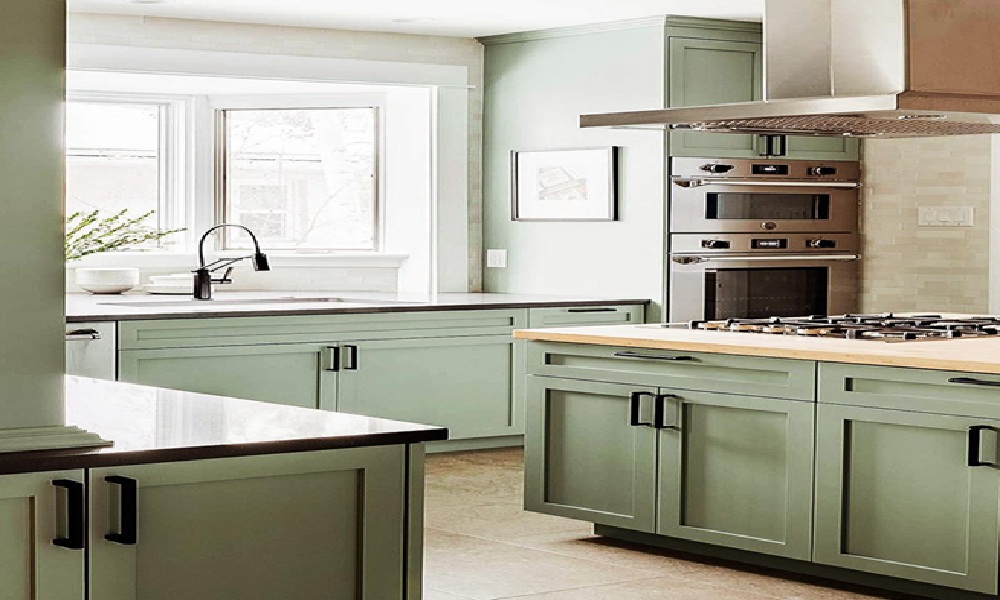Sage green kitchen cabinets have become a popular design choice for their soothing, earthy tone that brings warmth and tranquility to any home. When paired with wood accents, these cabinets create an inviting, organic aesthetic that feels both stylish and timeless. Wood accents, whether through countertops, open shelving, or floors, can elevate the sage green hue by adding natural texture and depth.
In this article, we’ll explore the best wood tones to complement sage green cabinets, design ideas inspired by farmhouse, rustic, and Scandinavian styles, and tips for blending wood textures with painted cabinetry for a harmonious look.
1. Best Wood Tones to Complement Sage Green Cabinets
Choosing the right wood tone is essential to achieving a balanced and cohesive look with sage green kitchen cabinets. The wood tone you select can influence the mood and style of your kitchen—whether you want it to feel bright and airy or rich and cozy.
a) Light Oak
Light oak is a soft, neutral wood tone that pairs beautifully with sage green. Its light, golden hue adds warmth and brightness without overpowering the space.
-
Why It Works: The subtle grain and soft color of oak create an understated yet sophisticated look.
-
Design Style: Ideal for Scandinavian and modern farmhouse kitchens.
-
Ideas: Incorporate light oak with floating shelves, butcher block countertops, or a light wood kitchen island.
b) Walnut
Walnut is a darker, rich-toned wood with a deep brown hue that adds contrast and depth to sage green cabinetry.
-
Why It Works: Walnut’s rich, warm undertones complement sage green’s muted earthiness, creating a luxurious and grounded aesthetic.
-
Design Style: Perfect for mid-century modern or rustic kitchens.
-
Ideas: Use walnut for open shelving, cabinetry accents, or a bold wooden range hood cover.
c) White Ash
White ash is a pale, creamy wood with a fine grain that adds softness and texture to the space.
-
Why It Works: Its neutral hue enhances the light and airy feel of sage green cabinets, making the kitchen feel open and inviting.
-
Design Style: Great for Scandinavian and coastal-inspired kitchens.
-
Ideas: Consider white ash for flooring, dining tables, or ceiling beams to add subtle texture.
d) Mahogany
Mahogany is a dark, reddish-brown wood that adds drama and sophistication to sage green cabinetry.
-
Why It Works: The deep, rich tones of mahogany create a striking contrast against the softness of sage green, adding a bold and luxurious touch.
-
Design Style: Works well in rustic, traditional, or eclectic kitchens.
-
Ideas: Use mahogany for cabinet hardware accents, butcher block countertops, or decorative trim.
e) Reclaimed Wood
Reclaimed wood, with its weathered patina and natural imperfections, adds character and a rustic charm to sage green cabinets.
-
Why It Works: The varied tones and textures in reclaimed wood provide a sense of history and authenticity that complements the organic feel of sage green.
-
Design Style: Ideal for farmhouse and rustic kitchens.
-
Ideas: Incorporate reclaimed wood with open shelving, accent walls, or exposed beams.
2. Design Ideas for Sage Green Cabinets and Wood Accents
The combination of sage green cabinets and wood accents can suit various design aesthetics, from cozy and rustic to sleek and Scandinavian. Below are some inspiring kitchen design ideas:
a) Farmhouse-Inspired Sage Green Kitchen
A farmhouse kitchen with sage green cabinets and wood accents offers a warm, inviting ambiance perfect for family gatherings.
-
Cabinet Style: Shaker-style sage green cabinets for a classic farmhouse look.
-
Wood Accents: Light oak or reclaimed wood for open shelving, countertops, or ceiling beams.
-
Decor Tips: Add rustic touches such as vintage lighting, ceramic jars, and an apron-front farmhouse sink.
-
Flooring: Consider wide-plank wooden floors to enhance the farmhouse vibe.
b) Rustic Charm with Sage Green and Dark Wood
A rustic kitchen embraces natural textures and earthy tones to create a cozy and lived-in feel.
-
Cabinet Style: Sage green cabinets with a distressed or matte finish for an aged look.
-
Wood Accents: Use dark walnut or mahogany for countertops, range hoods, or exposed shelving.
-
Decor Tips: Incorporate cast iron pans, woven baskets, and warm lighting for added character.
-
Flooring: Choose dark wood or stone tile floors to enhance the rustic aesthetic.
c) Scandinavian Minimalist Sage Green Kitchen
Scandinavian design focuses on simplicity, light, and natural elements, making it a perfect match for sage green cabinets.
-
Cabinet Style: Flat-panel sage green cabinets with minimal hardware for a sleek, modern look.
-
Wood Accents: White ash or light oak for floating shelves, wooden stools, or a dining table.
-
Decor Tips: Add neutral-toned textiles, potted plants, and simple ceramic dinnerware.
-
Flooring: Opt for light wood or whitewashed floors to keep the space bright and airy.
d) Coastal Kitchen with Sage Green and Driftwood Tones
For a breezy, beach-inspired kitchen, pair sage green cabinets with driftwood-toned accents for a relaxed, coastal vibe.
-
Cabinet Style: Sage green cabinets with glass-front uppers to display coastal-inspired decor.
-
Wood Accents: Driftwood or bleached wood for shelving and countertops.
-
Decor Tips: Add sea glass decor, nautical-inspired lighting, and white shiplap walls.
-
Flooring: Light wood or sand-colored tiles to complement the coastal aesthetic.
3. Tips for Blending Wood Textures with Painted Cabinetry
Combining sage green cabinetry with wood accents requires careful consideration to avoid clashing colors or overwhelming the design. Here are some tips to achieve a cohesive look:
a) Stick to One Dominant Wood Tone
Using too many different wood tones can create a disjointed look. Choose one primary wood tone for major elements like countertops or flooring, and use a complementary tone for smaller accents like shelves or furniture.
b) Match Undertones
When selecting wood, consider its undertones (warm, cool, or neutral) and ensure they complement the undertones of your sage green cabinets. For example, pair warm-toned sage green with golden oak, or cool-toned sage green with grayish driftwood.
c) Use Contrast Strategically
If your cabinets are a soft, muted sage green, consider using dark walnut or mahogany accents for contrast. Conversely, if your cabinets have a deeper green hue, opt for light wood accents like white oak or ash to brighten the space.
d) Incorporate Natural Light
Natural light enhances the warmth and texture of both wood and painted cabinetry. Large windows, skylights, or glass doors can make your sage green cabinets and wood accents shine.
Conclusion
Sage green kitchen cabinets paired with wood accents create a stunning, nature-inspired kitchen that feels warm, inviting, and timeless. Whether you prefer the rustic charm of reclaimed wood, the elegance of walnut, or the minimalist beauty of light oak, there’s a wood tone to complement your sage green cabinets.
By drawing inspiration from farmhouse, rustic, and Scandinavian styles, you can design a space that suits your personal taste and lifestyle. With the right combination of colors, textures, and natural light, your kitchen will become a serene, stylish retreat that you’ll love for years to come.

